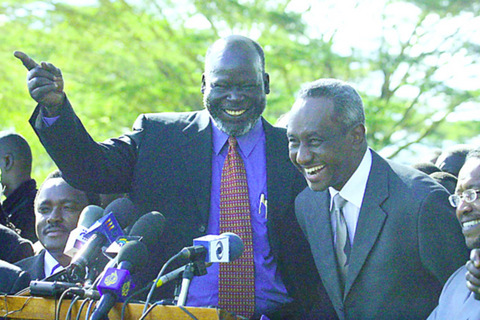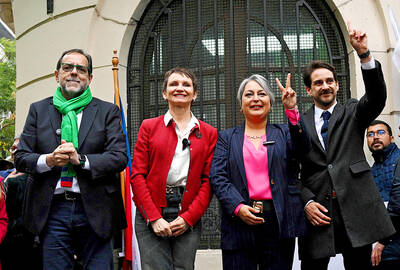Sudan's main rebel leader John Garang, who will sign a peace deal with President Omar el-Beshir tomorrow, ending more than two decades of civil war in south Sudan, once shifted his allegiances over the Cold War and its aftermath to win his people a vote on independence.
Now, he is set to become Sudan's senior vice president after the country's parliament enacts a transitional constitution -- based on the peace agreement -- by Feb. 20.

PHOTO: AFP
With the full blessing of Washington, the balding US-educated economist-turned-guerrilla once derided as a Soviet stooge, has finally won respectability as the leader of an internationally endorsed autonomous administration.
But as he swaps his military fatigues for civilian clothes, he faces the daunting task of rebuilding one of Africa's least developed regions after the continent's longest-running conflict.
Born in the remote Bor district in 1945, near the River Nile, Garang was one of the few in British-controlled southern Sudan to enjoy education beyond primary level.
After completing his secondary education in Tanzania, he went on to study economics at Grinnell College, Iowa.
In 1970, he walked away from the offer of a graduate fellowship at the University of California, Berkeley, to take up arms against the Khartoum regime.
The so-called Anyanya uprising ended with a 1972 Addis Ababa peace agreement under which Garang joined the Sudanese military, eventually rising to the rank of colonel and receiving training at the US army infantry school in Fort Benning, Georgia.
He returned to the bush in September 1983 after then president Gaafar Mohammed Nimeiri imposed Islamic law in defiance of the 1972 truce. Ironically, Garang had been sent by the government to suppress a mutiny by southern troops in his home district of Bor.
The 105 Battalion of the Sudanese army, which he had commanded in the 1970s, became the nucleus of the rebel Sudan People's Liberation Army (SPLA).
Washington's Cold War alliance with the Khartoum government prompted Garang to throw in his lot with the pro-Soviet government in neighboring Ethiopia.
He was later to dismiss the alliance as a "marriage of convenience."
The overthrow of the Soviet-backed regime in Addis Ababa in 1991 prompted a disastrous split in rebel ranks which brought Garang to his lowest ebb.
The SPLA divided on ethnic lines with Garang maintaining the support of his Dinka tribe, while the rival Nuer sided with breakaway leader Riek Machar.
The subsequent internecine fighting between the two sides appalled even sympathizers of the southern cause.
A 1994 report by New York-based Human Rights Watch accused all sides of gross violations of the rules of war, while aid agencies accused rebel and army commanders alike of diverting desperately needed relief supplies.
In the early 1990s, the regime gave refuge to Osama bin Laden, a decision that prompted a US missile strike on the Sudanese capital in 1998.
The election in 2000 of US President George W. Bush, whose Republican Party included many Evangelical sympathizers with the Christian cause in south Sudan, provided a further boost.
Through the long negotiations that followed a framework agreement in July 2002, it was Washington that maintained the momentum propelling the two sides forward.
Now that the war is finally over, Garang makes no secret of how much remains to be done to win the peace.
"We haven't had tarmac roads since creation. We are literally starting from scratch," Garang said earlier this year in his interim capital of Rumbek.

Drug lord Jose Adolfo Macias Villamar, alias “Fito,” was Ecuador’s most-wanted fugitive before his arrest on Wednesday, more than a year after he escaped prison from where he commanded the country’s leading criminal gang. The former taxi driver turned crime boss became the prime target of law enforcement early last year after escaping from a prison in the southwestern port of Guayaquil. Ecuadoran President Daniel Noboa’s government released “wanted” posters with images of his face and offered US$1 million for information leading to his capture. In a country plagued by crime, members of Fito’s gang, Los Choneros, have responded with violence, using car

Two former Chilean ministers are among four candidates competing this weekend for the presidential nomination of the left ahead of November elections dominated by rising levels of violent crime. More than 15 million voters are eligible to choose today between former minister of labor Jeannette Jara, former minister of the interior Carolina Toha and two members of parliament, Gonzalo Winter and Jaime Mulet, to represent the left against a resurgent right. The primary is open to members of the parties within Chilean President Gabriel Boric’s ruling left-wing coalition and other voters who are not affiliated with specific parties. A recent poll by the

TENSIONS HIGH: For more than half a year, students have organized protests around the country, while the Serbian presaident said they are part of a foreign plot About 140,000 protesters rallied in Belgrade, the largest turnout over the past few months, as student-led demonstrations mount pressure on the populist government to call early elections. The rally was one of the largest in more than half a year student-led actions, which began in November last year after the roof of a train station collapsed in the northern city of Novi Sad, killing 16 people — a tragedy widely blamed on entrenched corruption. On Saturday, a sea of protesters filled Belgrade’s largest square and poured into several surrounding streets. The independent protest monitor Archive of Public Gatherings estimated the

Irish-language rap group Kneecap on Saturday gave an impassioned performance for tens of thousands of fans at the Glastonbury Festival despite criticism by British politicians and a terror charge for one of the trio. Liam Og O hAnnaidh, who performs under the stage name Mo Chara, has been charged under the UK’s Terrorism Act with supporting a proscribed organization for allegedly waving a Hezbollah flag at a concert in London in November last year. The rapper, who was charged under the anglicized version of his name, Liam O’Hanna, is on unconditional bail before a further court hearing in August. “Glastonbury,